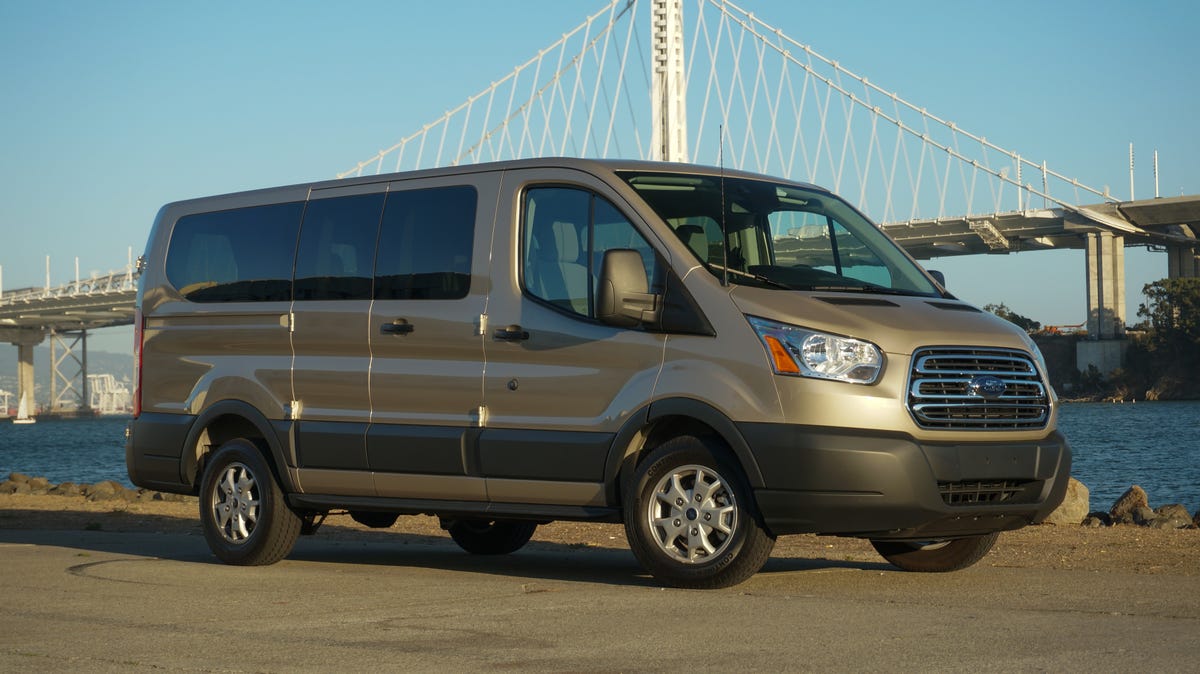All aboard the 2015 Ford Transit 150 XLT! (pictures)
With room for eight souls and over 20 large suitcases, we hit the road in one of the largest vehicles to ever pass through CNET's garage.

2015 Ford Transit 150 XLT wagon
Recently, I described Ford's Flex crossover as "a big box on wheels." I take it back: this is a big box on wheels.
Ford's Transit 150 is a full-size van for commercial, fleet and livery uses.
In the XLT wagon trim level, the van begins to resemble something that an individual buyer would conceivably purchase.
Capacious is the word that immediately springs to mind when describing the Transit 150...and this isn't even its largest form.
Here we see the medium wheelbase model with the low roof, but long and extended wheelbase configurations are available with two taller roof options.
Our example comes equipped with an optional rear camera, which makes living with the 220-inch long "wagon" easier.
83.6 inches tall by 81.3 inches wide, the Transit appears squared-off when viewed head on.
The van's short nose features hood intakes. One of the two is functional; the other merely adds symmetry.
Crammed into the engine bay is a 3.7-liter V-6 engine, good for 275 horsepower.
Power is sent to the rear wheels via a six-speed transmission. Two final drive choices are available when optioning the Transit.
The workhorse Transit uses a hydraulic-assist steering rack, rather than a more modern and efficient electric system.
Around town and on the highway, the Transit is easy to drive -- once you get used to the too-tall seating position.
I averaged about 17.7 mpg during my highway-heavy testing cycle. That lines up favorably with the EPA's estimated 16 combined mpg.
The Transit is highly configurable. For example, it can be had as an empty shell or with seats, with sliding doors or a pair of hinged swingers.
When equipped with seats, the Transit is referred to as a wagon. In the standard wheelbase, there's room for 8 souls (11 with the optional fourth row).
With all three rows in place, there's still space enough for up to 23 large suitcases stacked high.
The rear doors have a locking feature that allow them to be held open when loading or hauling longer items.
They can also be unlocked, freeing the range of motion.
Unfettered, the doors can swing a full 180 degrees.
The cabin aesthetic has more in common with Ford's compact hatchbacks than its full-size trucks. This dashboard is a dead ringer for the Ford Focus'.
The six-speed automatic transmission is controlled via a dash-mounted shifter.
There's no shortage of storage bins and cupholders ahead of the driver. This bin looks like it could easily swallow a 1-liter beverage.
Front and center is the optional MyFord Touch infotainment system, a 6.5-inch touchscreen suite with navigation, digital media and communication functions.
Techie van fans will want to wait for 2016 MY examples to arrive with the much improved Sync 3 infotainment stack.
Audio quality wasn't at the top of the hierarchy of amenities. The six-speaker system sounds fine, but not great.
Instrumentation is simple. The upgrade to lane-keeping assist and cruise control adds a full-color, but compact, LCD.
The steering wheel features controls for Sync voice commands, truly the highlight of this vehicle's tech offerings.
With the optional lane departure alert, the van can notify the driver when drifting out of its lane without signaling.
Low on the dash is the bank of inputs, including RCA video inputs, an SD card for map data, and two USB ports for charging and playback.
With the optional 110V inverter, small appliances and electronics can be powered on-the-go.
The 3.7-liter engine can run on E85 Flex Fuel. It can also be configured to accept cleaner burning compressed natural gas or liquid petroleum gas (CNG/LPG) with a factory upgrade.
The long Transit's blind-spot monitoring system works the old fashioned way: with a convex mirror and the driver's eyes.
The 2015 Ford Transit 150 wagon starts at $32,270, but XLT upgrades and accoutrements push the price up to $33,770.
Close to fully loaded, our example stickers for $38,750.

